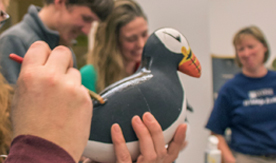Passing the Test

How old is a deer that has all its teeth and three cups on the four premolars?
Eighteen months old.
Which species of tree was the Carolina Parakeet’s primary food source?
The bald cypress.
Which university rapidly and successfully fielded a variety of far-ranging wildlife questions — including law, policy and forestry — to place second among 22 teams from the United States and Canada at The Wildlife Society’s 2014 National Quiz Bowl?
The University of Maine.
Marie Martin, Abigail Feuka, Caitlin Gunn, James Petersen and Karla Boyd — undergraduate members of the UMaine Student Chapter of The Wildlife Society — proved their expertise during a six-hour Jeopardy!-like competition in October at the 21st Wildlife Society Annual Conference in Pittsburgh, Pennsylvania.
At the National Quiz Bowl, they were asked to view a live snake and provide the name of the species. They also were challenged to rattle off Latin animal phyla names, distinguish species of birds by their auditory calls, identify trees and answer policy questions, says faculty adviser Faren Wolter, a certified wildlife biologist.
UMaine’s second-place finish is even more impressive, says Wolter, considering it was the first time in a number of years that the Black Bears participated in the national competition.
“That speaks volumes about how well our students were prepared,” Wolter says, adding she was equally impressed with the poise and collegiality of UMaine contestants.
Team captain Martin says the squad’s composure and runner-up finish indicates the quality of the Department of Wildlife, Fisheries, and Conservation Biology that rewards naturally curious individuals. “It is because of our natural propensity towards that information that we were so successful,” she says.
Boyd, a wildlife, fisheries, and conservation biology major with a conservation biology concentration, says UMaine’s quiz bowl participants were wonderful ambassadors for the university.
“Most schools were nervous and competitive, and we went up and wished everyone well, but didn’t put any stress on ourselves to come out on top, and we still did really well,” says the resident of Hilton Head Island, South Carolina.
The Lumberjacks of Humboldt State University in California bested Maine in the championship round. The Lumberjacks, who take a three-credit course to prepare for the competition, tore through the field en route to their 10th title in the 17 years.
UMaine outscored State University of New York College of Environmental Science and Forestry (SUNY ESF) to advance to the final. It was victory for the Black Bears; Wolter says SUNY ESF topped the Black Bears at a regional conclave earlier this school year at Pennsylvania State University.
The UMaine students’ varied wildlife interests — including fisheries, insects and statistics — buoyed the Black Bears’ expertise and balance, Wolter says.
Petersen, for instance, needs to hear only a fraction of a second of a birdcall to identify the species, says Wolter of the wildlife ecology major from Summit, New Jersey.
Petersen, who is on track to graduate in December, says he appreciated other aspects of the annual meeting as well, including the resume critique.
His teammates, including Gunn from Hampden, Maine, agreed the myriad of chances to network and learn at the conference were beneficial.
“I had the opportunity to have my resume critiqued, attend a trapping workshop and, overall, I was highly intrigued by the speakers and posters on current research being conducted around the globe,” says Gunn, a wildlife ecology major with a wildlife science and management concentration.
Feuka, who is slated to graduate in 2016 with a degree in wildlife ecology and a minor in Earth sciences, also valued the chance to interact with experts.
“My favorite part of the conference by far was meeting a so many accomplished scientists, policy specialists, game wardens, managers, professors and students all in one place,” says the resident of Perry, Michigan. “It was a wealth of knowledge and experience all in one place, and I was able to make some great connections because of this.”
The Wildlife Society, based in Bethesda, Maryland, is an international network. It seeks to “inspire, empower, and enable wildlife professionals to sustain wildlife populations and habitats through science-based management and conservation,” according to its website.
The 33 members of the UMaine Student Chapter of The Wildlife Society meet weekly. The group, founded December 1964, is open to all majors and was formed so students could gain experience and skills in wildlife science as well as to network and learn about graduate school and employment opportunities.
The UMaine group recently teamed with the Unity College Chapter of the Wildlife Society to bring a speaker from Tigers for Tigers to Maine. Tigers for Tigers is a coalition of colleges with tiger mascots that works to preserve wild tigers through national and international education, research and service learning projects.
Members of the UMaine student chapter also regularly repair duck nesting boxes at area refuges, participate in the annual Maine Cooperative Owl Survey organized by Maine Audubon and Maine Department of Inland Fisheries and Wildlife and collect biological data from moose killed in the annual fall hunt.
Students interested in learning more about the UMaine chapter are encouraged to contact Abigail Feuka at abigail.feuka@maine.edu, check out the webpage at umaine.edu/tws or follow on Facebook at facebook.com/pages/UMaine-Student-Chapter-of-The-Wildlife-Society/163415750437999.
Contact: Beth Staples, 207.581.3777
